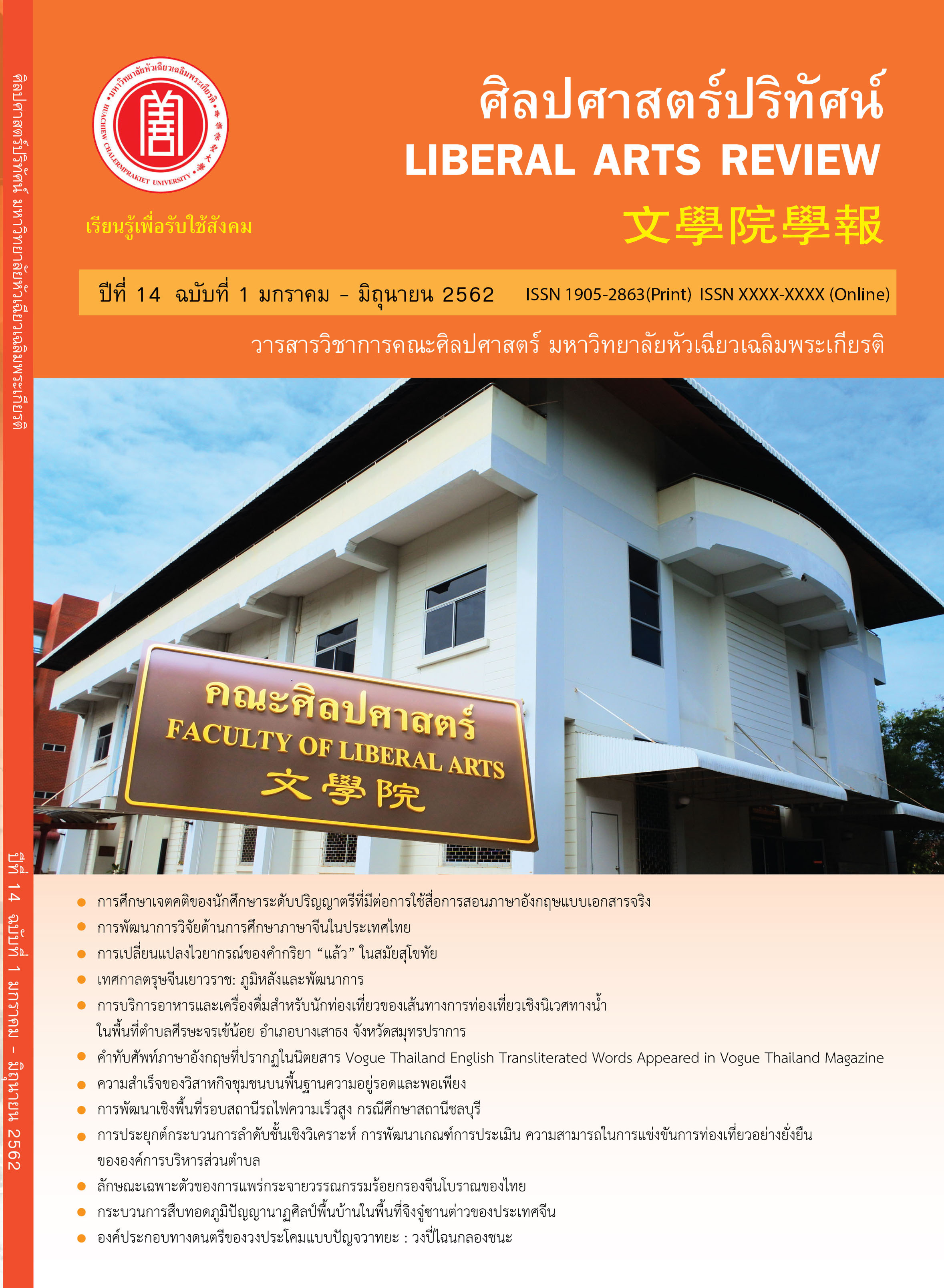The Application of an Analytic Hierarchy Process and Development of Assessment Criteria inof Sustainable CompetitiveTourism of Subdistrict Administration Organizations
Keywords:
competitiveness, sustainable tourism development, subdistrict administrations, analytic hierarchy processAbstract
The purpose of this research was to prioritize the components and indicators ofcriteria for assessing criteria in sustainablecompetitivetourism of subdistrictadministration organizations by using analytic hierarchical processes from 4 groups of experts, with 6 experts in total.Thecriteria consistedof seven components with 24 indicators:1) tourism management (0.251) (4 indicators) 2) leadership of local administration and human capital (0.1698) (2 indicators)3)tourism products and services innovation (0.1540)(3 indicators) 4) tourism marketing (0.1366)(4 indicators) 5) value and tourism knowledge management (0.119)(2 indicators) 6)sustainable tourism development (4 indicators) (0.1063) and 7)tourism destination competitiveness (0.0616)(5 indicators). The criteria reduce the ambiguity when experts priortizethe sustainable tourism destination competitiveness.The indicators are essential for assessing criteria in competitiveness of the sustainable tourism of the subdistrict administration organizations efficiently.
References
กระทรวงการท่องเที่ยวและกีฬา. (2560). รายงานภาวะเศรษฐกิจท่องเที่ยวฉบับที่ 7.กรุงเทพมหานคร: ผู้แต่ง.
คณะกรรมการนโยบายการท่องเที่ยวแห่งชาติ. (ม.ป..ป). แผนพัฒนาการท่องเที่ยว ฉบับที่ 2 (พ.ศ. 2560-2564).กรุงเทพมหานคร:สำนักงานปลัดกระทรวงกํารท่องเที่ยวและกีฬํา.
นิศารัตน์ วิเชียรศรี, และ กษมาพรรัชดา. (25 ธันวาคม 2560). ก.ท่องเที่ยว คาดปี 61 รายได้การท่องเที่ยว 3 ล้านล้านลบ.โต 9% มาจากต่างชาติ 2 ล้านลบ.-ไทยเที่ยวไทย 1 ล้านลบ. ค้นคืนจาก
https://www.ryt9.com/s/iq03/2759725
บุญเลิศ จิตตั้งวัฒนา. (2557).การพัฒนาการท่องเที่ยวอย่างยั่งยืน.กรุงเทพมหานคร:เพรส แอนด์ ดีไซน์.
วิฑูรย์ ตันศิริคงคล. (2557). AHP การตัดสินใจขั้นสูงเพื่อความก้าวหน้าขององค์กรและความอยู่ดีมีสุขของมหาชน.กรุงเทพมหานคร: อัมรินทร์.
สัจจา ไกรศรรัตน์,และวรรักษ์ สุเฌอ. (2560). แนวทางการพัฒนาเอกลักษณ์ตราสินค้าสำหรับชุมชนโบราณในฐานะแหล่งท่องเที่ยว: กรณีศึกษาตลาดร้อยปีสามชุก และตลาดเก้าห้อง จังหวัดสุพรรณบุรี.
วารสารรัชต์ภาคย์, ฉบับพิเศษ ครบรอบ 23 ปี, 125-142.
Asker, S., Boronyak, L., Carrard, N., &Paddon, M. (2010). Effective community based tourism. A best practice manual.APEC tourism working group. Retrieved July, 10, 2012.
Barney, J. (1991). Firm resources and sustained competitive advantage. Journal of Management, 17(1), 99-120.
Crouch, G. I., & Ritchie, J. B. (2000). The competitive destination: A sustainabilityperspective. Tourism Management, 21(1), 1-7.
Cucculelli, M., &Goffi, G. (2016).Does sustainability enhance tourism destination competitiveness? Evidence from Italian destinations of excellence.Journal of Clear Production, 111(Part B), 370-382.
Dickman, S. (1996).Tourism: An introductory text. (2nded.). Sydney: Hodder Education.
Dwyer, L., & Kim, C. (2003).Destination Competitiveness: An Analysis of Determinant Attributes.Journal of Travel Research, 50(1), 27-45.
Dwyer, L., Cvelbar, L. K., Edwards, D., &Mihalic, T. (2012). Fashioning a destination tourism future: The case of Slovenia. Tourism Management, 33(2), 305-316.
Goffi, G. (2013). A model of tourism destination competitiveness: The case of the Italian destinations of excellence.AnuarioTurismo y Sociedad, xiv, 121-147.
Gomezelj, D. O., &Mihalič, T. (2008). Destination competitiveness-Applying different models, the case of Slovenia. Tourism Management, 29(2), 294-307.
Gossling, S., Hall, C. M., & Weaver, D. B. (2012).Sustainable tourism futures perspectives onsystems, restructuring and innovations. New York: Routledge.
Grant, R. (1996). Toward a Knowledge Based Theory of the Firm. Strategic Management Journal, 17(2), 109-122.
Haven-Tang, C., & Jones, E. (2012). Local leadership for rural tourism development: A case study of Adventa, Monmouthshire, UK. Tourism ManagementPerspectives,
4(October), 28-35,Retrieved fromhttps://www.pasosonline.org/Publicados/10212 special/PS0212_03.pdf
Ireland, R. D., Hoskisson, R.E., &Hitt, M.A. (2006).Understanding business strategy: Concepts and cases. Ohio: Thomson South-Western College Pub.
Kotler, P. (2000). Marketing management. New Jersey: Prentic-Hall.
Kotler, P. (2017). Marketing 4.0 moving from traditional to digital. Hoboken, New Jersey: John wiley& Sons.
Krstić, B., Sekulić, V., &Ivanović, V. (2014). How to Apply the Sustainability Balanced Scorecard Concept/KakoPrimenitiKonceptKarteIzbalansiranihPerformansiOdrživog Razvoja. Economic Themes, 52(1), 65-80.
Liu, T. W., & Chin, K. S. (2010). Development of audit system for intellectual property management excellence. Expert Systems with Applications, 37(6), 4504-4518.
Poon, A. (2010). Trends and issue in global tourism. Berlin: Springer.
Porter, M. E. (1980). Competitive strategy: Techniques for analyzing industries and competitors.New York: Free Press.
Saaty, T.L., & Vargas, L.G., (2012).Models, methods, concepts & applications of the analytic hierarchy process (2rd ed.). New York: Springer Science+Business Media.
Singh, R. (2014). Marketing mix for sustainable tourism.IJMRR, 4(8), 825-829.
Teece, D. J., Pisano, G., &Shuen, A. (1997). Dynamic capabilities and strategic management. Strategic Management Journal, 18(7), 509-533.
Vodeb, K. (2014). Sustainable competitiveness of destination and resident's attitude towards tourism.InTourism and Hospitality Industry section 1-6, University of Rijeka, Faculty
of Tourism and Hospitality Management. Retrieved from https://ideas.repec.org/p/tho/iscthi/section1-6.html
World Economic Forum.(2017). The Travel and Tourism Competitiveness Report 2017. Retrieved from https://www.weforum.org/reports/the-travel-tourism-competitiveness
-report-2017.
Downloads
Published
How to Cite
Issue
Section
License
บทความที่ได้รับการตีพิมพ์เป็นลิขสิทธิ์ของวารสารศิลปศาสตร์วิชาการและวิจัย
ข้อความที่ปรากฏในบทความแต่ละเรื่องในวารสารวิชาการเล่มนี้เป็นความคิดเห็นส่วนตัวของผู้เขียนแต่ละท่านไม่เกี่ยวข้องกับมหาวิทยาลัยหัวเฉียวเฉลิมพระเกียรติ และคณาจารย์ท่านอื่นๆ ในมหาวิทยาลัยฯ แต่อย่างใด ความรับผิดชอบองค์ประกอบทั้งหมดของบทความแต่ละเรื่องเป็นของผู้เขียนแต่ละท่าน หากมีความผิดพลาดใดๆ ผู้เขียนแต่ละท่านจะรับผิดชอบบทความของตนเองแต่ผู้เดียว




